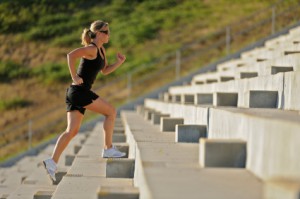 Carbohydrate is an essential component of sports nutrition.
Carbohydrate is an essential component of sports nutrition.
It provides the key source of energy to fund activity on a daily basis and to match the extra demands of exercise, training and competition.
Although recent media attention has focused on the need to reduce our intake of added sugars and the importance of monitoring carbohydrate intake in order to reduce the risk of obesity, heart disease and diabetes, carbohydrate foods (sugars and starches) are still essential for good health and exercise.
The key for all of us is to find out how many grams of total carbohydrate we need for general living and maintenance of a healthy body weight and then to learn how to ratchet our intake up and down to suit our energy requirements.
Factors affecting our carbohydrate requirements
- The type of exercise undertaken, its duration and intensity.
- The frequency of exercise bouts and opportunities for recovery of energy stores between them.
- Our body composition goals
- Extra demands for growth or body repair
- Environmental conditions,altitude, temperature etc.
- In the case of an athlete,their prior history of training and conditioning and goals for sporting performance.
The New Zealand Ministry of Health (MOH) recommend that we get 45-65% of our energy from carbohydrate which for an adult with an average intake of 8700kJ per day would work out to around 230-330g per day. People wanting to lose weight may need around 6000kJ depending on age and activity level. An athlete may need more depending on their age, health, type of sport its duration and intensity.
The MOH also recommend that 15-25% of our energy should come from protein and 20-35% from fat.
A Dietitian can help you to get these levels right for whatever goals you have in mind.
Carbohydrate stores are limited
Carbohydrate is stored as glycogen in the muscles and liver. However this storage capacity is limited and when the supply of carbohydrate fails to match an athletes extra needs for training and competition then performance can suffer as fatigue sets in and immune systems can fail.
Timing is everything
Carbohydrate foods are digested and absorbed within 1/2-2 hours depending on their Glycaemic Index.
The Glycaemic Index (GI)
This ranks carbohydrate rich foods on a scale 0-100 as high (>70), medium (55-70) or low (<50) according to their actual effects on blood glucose (i.e blood sugar) levels.
Overall low GI foods are best for long-term health and sustainable energy because they are more satiating and so help reduce overeating. They also help to reduce blood insulin levels so help to reduce insulin resistance and associated risk of metabolic syndrome, type 2 diabetes etc.
In sport understanding the GI can help us to select foods that will provide optimal energy at various stages of activity.
The Glycemic Load (GL)
Relates to the amount of food in questions by providing a measure for the degree of glycaemia and insulin demand relative to a normal serving of that food.
Glycaemic load = (GI x carbohydrate (g) per serving) ÷100.
A GL >20 is a high load; 11-19 is moderate and 10 or less is low.
Here is an example of some of these GI food groups but for a more extensive up to date list refer to the University of Sydney’s GI website: www.glycemicindex.com
Diag 1: Foods with a low, moderate and high Glycaemic Index and their Glycemic Load per serving
| Low GI <50 | Moderate GI 50-70 | High GI>70 | |||||||||
| wt(g) | GI | GL | wt(g) | Gi | GL | wt(g) | GI | GL | |||
| Mixed grain bread* | 30 | 49 | 6 | Pita bread,white | 30 | 57 | 10 | White bread | 30 | 70 | 10 |
| All Bran® | 30 | 30 | 4 | Weetbix® | 30 | 69 | 12 | Puffed Wheat® | 30 | 80 | 17 |
| Porridge | 250 | 55 | 12 | Cornflakes® | 30 | 77 | 20 | Waffles | 35 | 76 | 10 |
| Muesli, toasted | 30 | 43 | 7 | Muesli untoasted | 30 | 56 | 9 | Water crackers | 25 | 78 | 14 |
| Instant noodles, cooked* | 180 | 47 | 19 | Muesli bars | 30 | 61 | 13 | Coco pops® | 30 | 77 | 20 |
| Pasta, cooked,wholemeal | 180 | 37 | 16 | Basmati rice | 150 | 58 | 24 | Calrose rice | 150 | 83 | 35 |
| Milk low-fat | 250 | 32 | 4 | Ice-cream regular* | 50 | 61 | 8 | Spots drinks | 250 | 74 | 13 |
| Yoghurt,low-fat, unswt | 200 | 23 | 3 | Orange softdrink | 250 | 68 | 23 | Broadbeans | 80 | 79 | 9 |
| Baked beans* | 150 | 48 | 8 | Beetroot | 80 | 64 | 5 | Mashed potato | 150 | 91 | 18 |
| Chickpeas, canned | 150 | 42 | 9 | Muesli bars | 30 | 61 | 13 | Pumpkin | 80 | 75 | 3 |
| Sweet potato | 150 | 44 | 11 | New potato | 150 | 78 | 16 | French fries | 150 | 75 | 22 |
| Yams* | 150 | 37 | 13 | Banana* | 120 | 52 | 13 | Parsnip | 80 | 97 | 12 |
| Peas, green,boiled* | 80 | 48 | 3 | Ryvita® | 25 | 69 | 11 | Watermelon | 120 | 72 | 4 |
| Carrots | 80 | 41 | 2 | Raisins | 60 | 64 | 28 | Dates | 60 | 103 | 42 |
| Apple,raw | 120 | 38 | 6 | Pineapple* | 120 | 59 | 6 | Glucose | 10 | 102 | 10 |
| Pear,raw* | 120 | 38 | 4 | Kiwifruit | 120 | 58 | 7 | Bagels | 70 | 72 | 25 |
| Grapes,green | 120 | 46 | 8 | Popcorn* | 20 | 72 | 8 | Jelly beans* | 30 | 78 | 22 |
*Indicates an average range
Ref: The New Glucose Revolution -Brand-Miller,J. Foster-Powell,K.
High GI
70-100 (e.g. white bread, Puffed Wheat®) are rapidly digested and absorbed by the body and raise blood glucose levels very quickly within 30 minutes and then it fades.
In intense sporting situations these foods do have a place and can provide a fast source of energy for muscles and brain.
Pre-event:
These foods can be useful to athletes less than one hour before an event such as a first breakfast cereal/toast for an athlete undertaking rowing or swimming training early morning. However this breakfast does need to be followed up after training by a more substantial breakfast or mid-morning snack to provide sufficient energy for a morning of school or work.
During an event
High GI foods can also be useful during an event if it is of high intensity or will continue beyond 90 minutes in duration.
Post-exercise recovery
High GI foods may also aid recovery e.g. of fluids, body repair, energy stores etc, after extreme exercise of high intensity and duration e.g 1.5-2.5hrs in length, and for best results should be accompanied with some protein e.g a banana smoothie or fruit and yoghurt.
Although GI is useful to know about serious athletes need to understand how much carbohydrate in total they need to eat each day along with their protein,fat, vitamin and mineral requirements. Their diet needs to “wrap around” their periods of training and competition. As sports dietitian we can help you determine these amounts and an appropriate training/competition plan.
Recreational activity
On a daily basis children and adults, undergoing normal physical activity < 45-60 minutes, do not need Hi Gi foods and in fact an over consumption of foods such as sports drinks, lollies and chips can lead to peaks and troughs in blood sugar that may lead to sugar cravings, a greater risk of dental caries, type 2 diabetes and obesity.
Moderate GI Foods
55-70 (e.g. bananas, Weetbix®) are absorbed slightly more slowly into the blood stream than Hi GI foods and can also be a source of energy during and after exercise.
Low GI Foods
0-55 (e.g. bran cereal and mixed-grain bread) these foods are more slowly digested and absorbed and so lead to a more gradual rise in blood glucose levels . These foods can be used every day in main meals and snacks by everyone and for athletes 2-3 hours before endurance exercise.
Factors affecting the Glycemic Index
- The molecular structure of the food as well as its protein, fat and dietary fibre content will alter the GI.
- Reformulation of a processed foods may change it’s original GI rating.
- The Glycaemic Load i.e th portion size of the food and it’s carbohydrate content is important to that foods overall effect (see diagram above). For instance although watermelon, parsnip, beans and pumpkin have a Hi Gi they also have a high water content and low sugar content so over all their effect on blood sugar is quite low.
- Food processing appears to raise the GI. Which is why eating foods whole, if possible, is preferrable to the juicing of foods.
- An individuals response to the GI of foods may vary according to their body composition, level and type of exercise and history of training etc.
- The type of food. For instance there is no GI value for meat, nuts and avocado because these foods contain no or very low levels of carbohydrate so their GI can be regarded as zero.
GI recommendations for good health
- Choose breakfast cereals that contain barley,oats (e.g. porridge) wheat or rice bran.
- Choose grainy breads containing whole seeds, barley, oats rather than white or brown bread.
- Include legumes and pulses (e.g. beans,lentils and peas)
- Eat foods that are high in fibre as these slow the digestion and absorption of carbohydrates.
If you would like to discuss your carbohydrate intake then contact us today.
For more information read other articles by Lea on similar topics:
What’s the fuss about fructose?
Sugar control is essential for good health.
8 healthy tips when making “real food” choices.
Boosting fibre intake offers health benefits
References:
- Atkinson,F. Foster-Powell,K. Brand-Miller JC. International tables of glycemic index and glycemic load values: Diabetes Care,Dec 2008, 31,(12) 2281-2283.
- Brand-Miller, JC. Foster-Powell K. The New Glucose Revolution. Hodder 2002































































Leave a Reply